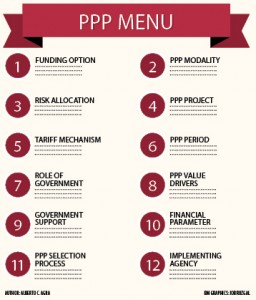‘Responsive-ility’ and responsibility Public-Private Partnership (PPP) arrangements—whether for water, reclamation, power, mass transport systems and…
The 75 choices on PPP menu
The 75 choices on PPP menu
 Why public-private partnership (PPP) for a road project and not procurement using public funds? Why do most local government units and water districts opt for joint ventures and not a build-operate-transfer scheme? Why will government assume the right-of-way risk and not the operations risk? Why use the lowest tariff, not the highest concession fee, as financial parameter for bulk-water supply project? Why bundle a reclamation project with land development and expressway, and why unbundle a radiology department from a PPP of the whole hospital? Why contribute the usufruct of government property and not cash in a PPP arrangement?
Why public-private partnership (PPP) for a road project and not procurement using public funds? Why do most local government units and water districts opt for joint ventures and not a build-operate-transfer scheme? Why will government assume the right-of-way risk and not the operations risk? Why use the lowest tariff, not the highest concession fee, as financial parameter for bulk-water supply project? Why bundle a reclamation project with land development and expressway, and why unbundle a radiology department from a PPP of the whole hospital? Why contribute the usufruct of government property and not cash in a PPP arrangement?
The answers to these questions can be found on the PPP menu. Like choosing from various cuisines and dishes, PPPs involve making choices from a host of options. Like ordering in a restaurant, not everything on the menu is ordered in one sitting, but food choices can be combined.
For PPPs, the alternatives revolve around what is more feasible, viable and acceptable.
The project must not only be legally justifiable but must be technically feasible, environmentally compliant, socially sustainable and economically viable, as well. Further, the PPP parties must be organizationally ready.
The 75 choices may be classified into 12 clusters. Here are the “viands” on the PPP menu:
- Funding option
- PPP
- Procurement using public funds
- Contracting a loan from a government bank
- All or some of the above
- Implementing agency
- National government
- State corporation
- Local government unit
- All or some of the above
- PPP value drivers/reasons
- Pursuant to a development strategy
- Better quality of life
- Resource scarcity
- Innovation
- Value-for-money
- Risk spread and sharing
- Acceleration of delivery
- All or some of the above
- PPP modality
- Any of BOT law-variants
- Joint venture
- Concession
- Lease
- Management or service contract
- Donation
- Divestment
- Corporatization
- PPP project
- Hard (Infrastructure)
- Soft (Social service)
- Combination
- PPP Period
- Long term
- Medium term
- Short term
- Risk Allocation
- Risk retention by government
- Risk transfer to private sector
- Risk sharing between the parties
- Government support
- Subsidy
- Guarantee
- Equity
- Performance undertaking
- Grant of concession
- Cash
- Asset
- Right-of-Way
- Government approvals
- Tax Incentives or holiday
- All or some of the above
- Role of government in operations
- Active
- Passive (Purely regulatory)
- Tariff mechanism
- Rate of return
- Price cap
- Revenue cap
- PPP selection process
- Open bidding (competitive selection)
- Limited negotiations (when bidding fails)
- Unsolicited proposal (competitive challenge)
12.Winning Financial parameter
- Highest payment to government
- Lowest government subsidy
- Lowest tariff by end-user
- Highest share in revenues
- Highest purchase price
- Highest rated bid (aualifications)
- Lowest calculated bid/price
Making the “right choice” is not one-size-fits-all or no-brainer exercise. There are no default choices. At the end of the process, the parties and the people must be happy with the “food choice.”
